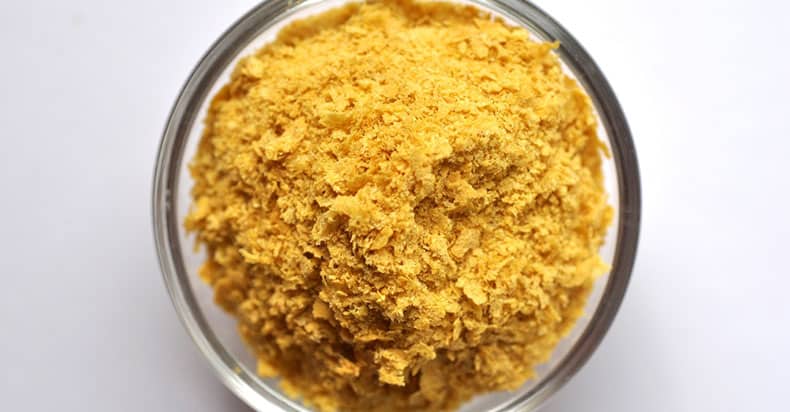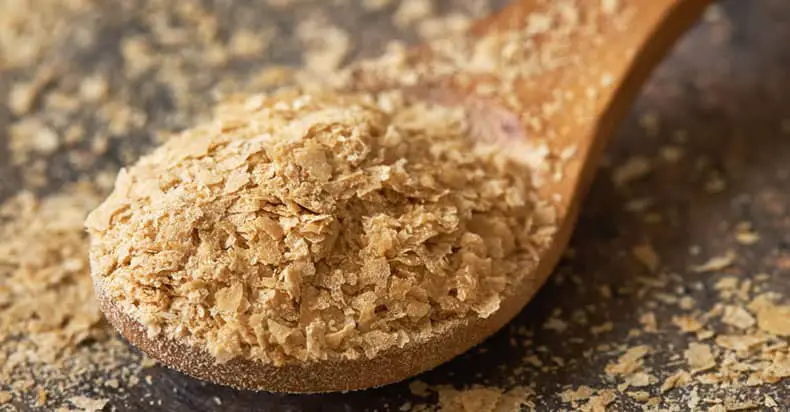Nutritional yeast has long been touted as a great vegetarian source vitamin B12—a nutrient that’s found naturally only in animal products, with meat and seafood being the main source. But, is it suitable for vegans? Are non-vegan nutrients added to it or used in its processing? Are yeast cells sentient?
We’ll be addressing these questions in this article and much more.
In short, is it vegan? Nutritional yeast is considered vegan. It does not contain animal products and its processing is cruelty-free. Nutritional yeast simply contains yeast cells and B vitamins which are produced industrially via chemical or microbial synthesis.1 Further, yeast cells, while alive, are not sentient.2
Now, we’ll look at why nutritional yeast is considered vegan-friendly, and then consider arguments levied by some in the vegan community as to why the substance should be avoided.
Nutritional Yeast vs. Baker’s and Brewer’s Yeast: Are They All Vegan-Friendly?
How do baker’s, brewer’s, and nutritional yeast differ?
Brewer’s, baker’s, and nutritional yeast make up the three main categories of yeast used in the food industry. They’re all considered vegan.
One, because they’re yeast cells which, while alive, lack a nervous system and thus consciousness and the ability to suffer.
Secondly, they’re produced and sourced very similarly in a cruelty-free process that doesn’t involve the use of animal products.
The vitamins found in yeast products are produced naturally or added later (as in the case of B12).
So you know, some, but not all, brands of nutritional yeast, come fortified with vitamin B12. When fortified, the vitamin B12 present in nutritional yeast is produced separately and then added.3,4
As mentioned above, other vitamins that are added after the fact, are produced microbially, or via chemical synthesis without the use of animal-derived precursors.
How Is Nutritional Yeast Made?
As mentioned, the production of nutritional yeast is similar to that of baker’s and brewer’s yeast. The strain of yeast is even the same, Saccharomyces cerevisiae (S. cerevisiae), with the exception of some baker’s yeast which can be made from Lactobacillus sanfrancisco (L. sanfrancisco ) or Candida milleri (C. milleri).
Unsurprisingly, baker’s yeast is the kind used for leavening breads and other baked goods. It tends to be S. cerevisiae, but C. milleri and L. sanfrancisco are sometimes used for sourdough bread. One other difference is that it’s dried at low temperatures so that the yeast isn’t killed—it needs to be alive to be used as a leavener.
Brewer’s yeast is a byproduct of the brewing industry that’s used as a nutritional supplement because it contains amino acids, B-complex vitamins, and minerals like chromium, phosphorus, calcium, and potassium.
Like baker’s yeast, brewer’s yeast is made from the pulverized cells of S. cerevisiae, but they are dried at high temperatures, so as not to contribute to leavening.
Finally, we have nutritional yeast. Like brewer’s yeast, nutritional yeast is used as a supplement, but it’s grown specifically for this purpose. It’s also made up of S. cerevisiae dried at high temp so it can’t be used as a leavener.5,6
It’s available in the form of powder and flakes and lacks the bitter taste you get from brewer’s yeast because it’s grown on a diet of molasses or sugarcane. Instead of being bitter, its taste is usually described as sweet, nutty, and cheesy.
The basic process of producing nutritional yeast starts with seeding.
A pure parent yeast culture is grown in flasks and then transferred to a larger fermentation tank, where it is cultivated.
Then there’s cultivation which involves optimizing growing conditions and feeding the yeast on a medium—again, usually molasses or sugarcane.
The cultures are then harvested and centrifuged to create an off-white liquid called “nutritional yeast cream.”
Finally, the yeast is fortified and then dried. Fortification involves deactivation of the yeast at which point vitamins or minerals are added to boost the nutritional profile.
The yeast is dried and processed into powder or flakes.
Is Nutritional Yeast Cruelty-Free?

Obviously, when considering how vegan-friendly a substance is, you have to look at what’s listed on the ingredients panel.
But another, often overlooked factor is whether any non-vegan ingredients are used in the production of a given food product. It’s often overlooked because these substances are not listed on the ingredients panel.
For example, some microbes are cultured using lactose, or milk sugar, usually alongside whey protein. Lactose, unlike lactate or lactic acid, is always dairy-derived and thus never vegan. When used for this purpose, lactose will not show up on the product label potentially sliding under the radar.
However, this is not the case with nutritional yeast. Nutritional yeast is cultured on a nutrient medium, which is usually glucose which tends to be sourced from beet molasses or sugarcane.
But Nutritional Yeast Tastes Meaty and Cheesy. How Can It Be Vegan?
Yes, nutritional yeast is usually described as having a meaty or cheesy flavor—which is why it’s such a great vegan parmesan replacement and why it’s used in making vegan cheeses and mock meats.
Make sure to check out the article on vegan cheese for more info on where non-dairy cheeses get their flavor.
However, this characteristic flavor is not due to the presence of meat or cheese. Fortunately, animal products do not have a monopoly on savoriness—aka the umami taste. Umami is one of the five main tastes perceived by the human tongue with the others being sweet, salty, sour, and bitter.
Umami is actually due to glutamic acid. This substance is abundant animal foods which is why it’s associated with meat. However, it’s also present in plant foods and fungi like yeast and mushrooms.
All inactive yeast (brewer’s and nutritional yeast) have a certain amount of glutamic acid. This is because when the yeast cells are killed or inactivated, proteins in the cell walls begin to degrade, breaking down into their constituent amino acids.
Glutamic acid is pretty abundant in yeast cells and cell walls.7
Keep in mind that vegan foods having a savory flavor are not limited to mushrooms, yeast, and plant-based product that naturally contain high amounts of glutamic acid (e.g. soy sauce). This is because the compound is used to make the popular food additive known as monosodium glutamate or MSG.
No matter what you’ve heard in the past, MSG is vegan-friendly. Some claim that it’s not healthy, but that’s a separate conversation. Which is what we’ll talk about next.
Why Some View Nutritional Yeast as Non-Vegan
More accurately, I’ve heard some say it shouldn’t be considered a “vegan health food”. I’m not quite sure what that statement means. A food can be vegan or non-vegan and healthy or non-healthy, so I see no reason why there should be a category for vegan health foods.
I’ve heard similar arguments about other food products. Whether it be oils or genetically modified foods, it’s not uncommon to encounter food taboos in the vegan community that are borne out of strictly health concerns.
Just know that the vegan status of a food has nothing to do with how healthy it is.
The definition for what constitutes a food product that’s vegan-friendly can range from those containing no animal-derived products (full stop) to foods that are both animal product free but whose production is cruelty-free and/or environmentally-friendly.
But, nutrients that are known to be unhealthy past a certain point—like table sugar, plant-based saturated fat, and sodium—are considered vegan.
Going forward we’ll just assume that those making the argument that vegans should avoid nutritional yeast are simply saying that it’s not healthy and shouldn’t be consumed in general.
Arguments for why nutritional yeast is unhealthy usually focus on MSG—nutritional yeast has naturally occurring MSG.
There’s lots of conflicting information on monosodium glutamate in terms of its health effects. Most of the concerns stem from earlier studies on the compound that showed negative health outcomes.
However, a lot of studies of much higher quality have been conducted since then and most authoritative and reputable sources of health-related info view the substance as generally safe for consumption.
For example, the Food and Drug Administration has repeatedly confirmed the safety of MSG at levels consumed by the general population.8
The Academy of Nutrition and Dietetics seems to be quite skeptical about MSG concerns, noting the methodological problems in the earlier studies.9
Not only is nutritional yeast considered healthy, but it can be especially useful for vegans because it contains vitamin B12.
Dr. Greger of NutritionFacts.org has made a series of videos implicating the widespread vegan B12 deficit as potentially contributing to an observed increased risk of stroke among plant-based dieters.11
As mentioned, B12 isn’t produced by the yeast cells. Rather it’s added to the yeast during production—so, nutritional yeast is really no different than supplements in this respect.
But, there is one benefit: the B12 in nutritional yeast comes in food form. This could be useful because many vegetarians (including vegans) can be pretty wary of taking supplements in general. Or, at least, it seems that way.
And the nutrient profile of nutritional yeast doesn’t stop with B12. Both fortified and unfortified nutritional yeast provides vitamins and minerals:12
- Nutritional yeast usually provides 20% DV and 5% DV iron for fortified and non-fortified yeast, respectively.
- Unfortified nutritional yeast often contains 35-100% DV of thiamine (vitamin B1).
- Unfortified nutritional yeast also provides about 35 to 100% DV for riboflavin (vitamin B2).
- Vitamin B6 in various amounts.
As for macros, values for nutritional yeast vary depending on the manufacturer. On average, 2 Tbsp. provides 60 calories with 4 grams of fiber. The same amount usually provides 9 grams of protein, a complete protein, providing all 9 amino acids.10
In sum, given the nutrient profile along with the lack of evidence behind MSG health concerns, nutritional yeast should be considered a “vegan health food” if such a category of food exists.
Is Nutritional Yeast Vegan? Conclusion
I hope this helps clear things up.
Yeast cells are not sentient so they’re vegan-friendly in and of themselves. The nutrients added to the yeast are vegan-friendly. Finally, the processes used industrially to make nutritional yeast are cruelty-free.
As for health concerns, they’re just that: concerns about personal health, not ethics concerning animals or the environment.
That’s not to say that health is unimportant, but it’s a separate conversation. The vegan diet is ultimately a boycott of foods containing animals or produced involving animal exploitation.
Finally, even if health were relevant, the concerns surrounding MSG consumption are largely based on outdated studies and personal anecdotes.
And given the benefits offered by nutritional yeast to vegans—namely, B12 in fortified nutritional yeast—consumption of the food product should be considered a net positive for 100% plant-based eaters.
References
- Jose L. Revuelta , et al. Microbial biotechnology for the synthesis of (pro)vitamins, biopigments and antioxidants: challenges and opportunities. Microb Biotechnol. 2016 Sep; 9(5): 564–567. https://www.ncbi.nlm.nih.gov/pmc/articles/PMC4993173/
- Animal Ethics: What Beings Are Not Conscious? https://www.animal-ethics.org/sentience-section/animal-sentience/beings-conscious/
- Best Natural Foods: Nutritional Yeast. http://bestnaturalfoods.com/nutritional_yeast.html
- Red Star Nutritional Yeast: The Five Steps in Manufacturing Nutritional Yeast. http://redstarnutritionalyeast.com/the-5-steps-in-manufacturing-nutritional-yeast/
- Understanding Food: Principles and Preparation (Page 377). Amy Brown – Wadsworth Cengage Learning – 2011. ISBN-10: 0-538-73498-1
- Industrial Exploitation Of Microorganisms. New Delhi: I.K. International Pub. House. 2010. Page 6. ISBN 9789380026534.
- Nutritional Yeast, Wikipedia. https://en.wikipedia.org/wiki/Nutritional_yeast
- Katherine Zeratsky, R.D., L.D. Mayo Clinic. What is MSG? Is it bad for you? https://www.mayoclinic.org/healthy-lifestyle/nutrition-and-healthy-eating/expert-answers/monosodium-glutamate/faq-20058196
- The Academy of Nutrition and Dietetics. Umami: The Science and Lore of Healthy Eating. https://www.andeal.org/vault/2440/web/Umami_Science_and_Lore_of_Health_Eating_201708.pdf
- Prater, D. “What Is Nutritional Yeast? How Will It Change You?” People for the Ethical Treatment of Animals. https://www.peta.org/living/food/nutritional-yeast-only-sounds-gross/
- Michael Greger M.D. FACLM. Vegetarians and Stroke Risk Factors—Vitamin B12 & Homocysteine? Volume 50. https://nutritionfacts.org/video/vegetarians-and-stroke-risk-factors-vitamin-b12-homocysteine/
- Fang, Huan, et al. (Jan 2017). “Microbial production of vitamin B12: a review and future perspectives”. Microbial Cell Factories. 16 (1): 15. https://www.ncbi.nlm.nih.gov/pmc/articles/PMC5282855/

